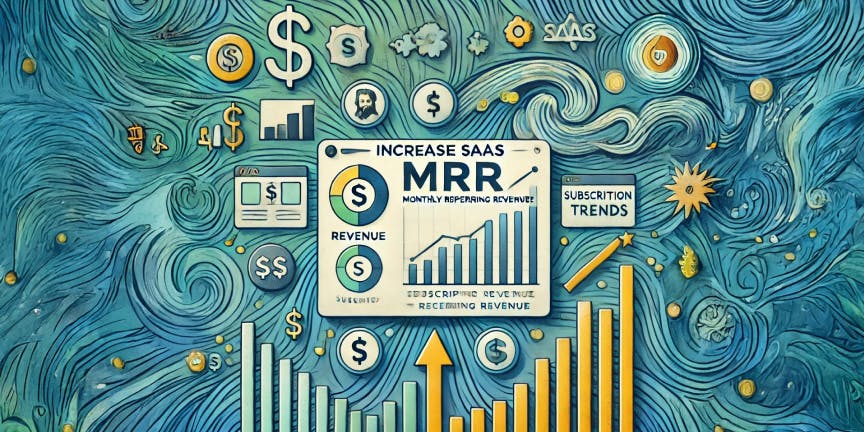Is your SaaS MRR stagnating? You’ve built a great product and brought in new customers, yet your Monthly Recurring Revenue (MRR) isn’t growing. So, what’s holding it back?
The truth is, having a fantastic SaaS product isn’t enough. Growth often stalls when factors like mismatched pricing, ineffective onboarding, or poor customer support quietly drag your business down.
Here’s the good news: With the right product-led growth strategies, you can grow your MRR and establish your SaaS product as an essential tool for your customers.
In this blog, we will learn how to increase your SaaS product's MRR, from upselling and customer retention to setting your business up for real financial growth. Let’s dive in and boost your monthly revenue.
Top Reasons to Prioritize MRR Growth for Your SaaS Product
MRR serves as a key growth benchmark for SaaS and subscription-based businesses. It shows how well your product meets customer needs and predicts recurring revenue from subscriptions.
Beyond tracking monthly revenue from existing customers, there are many reasons to focus on increasing MRR for your SaaS business:
1. Future financial planning
Monthly recurring revenue (MRR) provides a clear snapshot of your business's financial health and offers insights into future revenue growth.
Focusing on improving your MRR growth rate allows you to plan for predictable revenue growth and market trends, make informed strategic decisions, and allocate resources effectively.
2. Learn about your existing customers
Your monthly revenue reflects existing and new customers' engagement with your product. When your product delivers value, MRR grows.
Tracking MRR helps you uncover why customers invest in your business or churn, offering actionable insights to improve retention and satisfaction.
3. Scale your company’s growth
Increased MRR enables SaaS companies to explore new markets, reinvest in development, and maintain operational efficiency.
Here, a slight increase in the MRR reflects that your business can pursue long-term goals and maintain a growth trajectory against market fluctuations.
4. Reduce customer acquisition costs
When you focus on increasing net MRR growth, you invest more in aligning customer retention strategies and ensuring they feel valued.
Loyal customers can become brand advocates, driving referrals and reducing your reliance on marketing expenses and customer acquisition.
Moreover, retaining customers lowers CAC and scales your annual recurring revenue (ARR).
5. Attract investors and new opportunities
Consistent monthly recurring revenue (MRR) growth shows investors that your business steadily meets strong market demand and operates efficiently.
In addition to that, MRR growth not only builds investor confidence but also opens doors to new opportunities, such as additional funding, strategic partnerships, and innovative projects that drive the future forward.
10 Proven Strategies to Increase SaaS Product’s MRR Growth
MRR growth relies on strategies you follow and implement for your SaaS business. In this section, we will discuss how to improve your net MRR growth and focus on maximizing the value of your existing customers.
1. Optimize your SaaS pricing strategies
SaaS pricing isn't just a number but a key strategy to grow your net MRR growth rate. Static pricing can push customers away as it fails to match diverse needs. So, you must keep your pricing dynamic to engage different customer segments and drive more revenue.
Here are effective pricing strategies that align with your customer's needs and the value your SaaS product provides.
Increase your prices strategically
As a SaaS marketer or found, spend a few hours analyzing whether your product is underpriced or overpriced. If your product is underpriced, increase the price gradually by 105, 20%, or 50%.
While increasing your product's price, consider your competitor's pricing, profit margins, GOCS, and perceived value of your product. Also, test the price before increasing it to avoid unnecessary changes.
Introduce a tiered pricing model
Implementing a tiered pricing model allows you to capture the attention of a wider audience. Moreover, multiple subscription plans offer customers the flexibility to choose the pricing based on features they want, needs, and budget.
Example:
Jira — a project tracking software, offers tiered pricing to cater to different team sizes, needs, and budgets. It provides a variety of plans, including Free, Standard, Premium, and Enterprise levels. This pricing model enables businesses to select plans suited to their needs and scale, with the flexibility to upgrade as they grow.

Include a usage-based pricing model
Usage billing is a dynamic pricing model where customers pay based on actual consumption, making it fair and scalable. This pricing works best for SaaS, which offers measurable outputs, like 50 emails for $10 or tracked keywords in SEO.
Example:
HotJar uses usage-based pricing, letting customers pay only for what they use. This model helped the company reach a broader audience while boosting its net monthly recurring revenue. It's a win-win for both businesses and their customers.

2. Improve your customer retention
Chasing new customers is cheaper compared to retaining your existing customers. To improve net MRR growth, you just have to shift focus from acquisition to retention. The more your existing customers contribute, the more value you drive from them.
Key retention strategies to boost MRR growth:
- Personalized messages: Show customers they are valuable by sending tailored welcome messages, updates, or reminders after purchase. These small gestures strengthen their brand loyalty and deepen engagement.
- Educational content: Your SaaS product with many features may take some work to understand. You can simplify complex SaaS offerings with tutorials, webinars, or guides. Educated users find more value in your product, increasing loyalty and future revenue growth.
- Positive onboarding experience: First impressions count. A seamless onboarding experience with guides, demos, and personalized support helps customers quickly understand and benefit from your product.
- Build customer relationships: Beyond transactions—check-in, gather feedback, and reward loyalty with perks, discounts, or early access to features. These emotional and meaningful connections boost trust and long-term satisfaction.
3. Focus on upselling and cross-selling
Upselling and cross-selling are powerful strategies for increasing your SaaS product's MRR growth. To successfully use these strategies, identify the right moment to offer higher-tier plans, premium features, or complementary services to drive additional revenue from existing customers.
Upselling for increasing expansion MRR
Upsell premium features to current customers with free plans and offer exclusive features tailored to enterprise users. If this strategy works, it will boost expansion MRR, increasing the overall revenue growth rate.
Example: Dropbox's successful upselling strategy
Dropbox promotes paid plans by highlighting the limitations of its free version, such as restricted storage and basic features. It encourages users to upgrade for more storage and collaboration features (smart sync, file versioning, and shared link controls).
Cross-selling to add more value
Cross-selling focuses on providing complementary, non-essential products or features that enhance the value of their original purchase. These offers boost user satisfaction while increasing expansion revenue.
For instance, like being offered accessories after purchasing an iPhone, SaaS businesses can cross-sell additional features or tools to maximize customer lifetime value and engagement.
4. Expand to upmarket
Offering annual prepayment plans alongside monthly contracts is a proven way to drive net MRR growth. Annual plans encourage customer commitment, reduce mid-term churn rate, and encourage stickiness. This results in improving cash influx for reinvestment in growth strategies.
To turn free or monthly users into long-term customers, showcase the advantages of annual plans, including cost savings, uninterrupted service, and premium support access. These benefits can effectively motivate customers to make the switch.
Offer annual prepayment plans to exclusive customers, boosting MRR while increasing your ARR growth. This approach is profitable for customers and business—a win-win strategy for long-term success.
5. Strategic partnerships and collaborations
This expansion MRR strategy is value-driven for businesses and experts involved in strategic partnerships. It allows you to collaborate with industry experts and influencers with SaaS industry expertise, networks, and trust to connect with broader audiences.
Other benefits of strategic partnerships include:
- Expand your reach: Strategic collaboration with influencers or experts enables you to access their target audience and introduce your SaaS product to potential customers.
- Build credibility and trust: Partnerships with trusted names in your industry can improve brand reputation and boost customer confidence.
- Co-Create Opportunities: Collaborate with SaaS companies selling similar products and work on joint initiatives like webinars, events, or co-branded content.
Strategic collaborations attract revenue opportunities and position SaaS companies as innovative market leaders when aligned with industry trends.
6. Adopt a freemium model
The freemium model can significantly help increase MRR growth, but its success depends on implementation and strategy. It allows SaaS businesses to improve product adoption by lowering barriers while offering opportunities to convert free users into paying customers.
Here's how it can positively impact MRR growth:
- Low-risk trial: Allowing users to try the product for free, reducing financial barriers and expanding their user base.
- Convert engaged users: It enables new paying customers to explore core features for free. Once they see value in the product, they will be more likely to upgrade to paid plans.
- Build confidence: Users get to interact and experience your product without any barriers. If the product adds value and improves productivity, it builds their trust and confidence.
- Turn users into advocates: Positive experiences encourage them to become brand advocates and attract new audiences to try the product.
Example:
Slack adopted a freemium model that allowed users to access core features for free. Millions of teams from around the world use the platform. Many transitioned to paid subscriptions as their needs grew, driving steady MRR growth.

7. Offer better customer support
When customers feel valued and supported, they're more likely to stay loyal and continue using your SaaS product. Providing exceptional customer support is a proven way to improve retention and increase the net MRR growth rate.
Key customer support strategies to improve MRR growth rate:
- Address your customers' issues immediately and offer them solutions early.
- Make customers feel valued and have a sense of achievement with your product by offering resources and onboarding materials.
- Provide dedicated customer success managers to provide customers with fast and helpful responses.
- Offer personalized support based on customer's needs for better engagement and problem resolution.
8. Experiment with limited-time offers or discounts
Attracting and retaining your existing customers is easy with limited-time offers and discounts. It creates a sense of urgency when customers come across a last-time sale or significant discounts on a special day. This strategy encourages more customers to upgrade or make quick decisions when committing to the product.
You can drive revenue from new users by offering introductory discounts. Additionally, users feel satisfied when they get more features or services into discounted bundles that appeal to customer needs.
Example:
Spotify frequently uses promotional offers, such as discounted plans for students or family bundles, to expand its subscriber base and boost monthly recurring revenue.

9. Attract new revenue with fresh product catalog
Updated products can attract untapped customer segments, expand your user base, and improve your expansion revenue growth. You can also do one essential thing - analyze your current catalogue.
While analyzing it, make sure to ask these essential questions:
- Which product delivers the value your target customers are searching for?
- Do they address customers' pain points?
- Where can you improve to align with customer needs, market demand, or emerging trends?
A refreshed catalogue signals innovation, meets evolving expectations and drives consistent MRR growth.
10. Track your MRR growth and refine strategies
Analyzing your MRR growth is essential to refine your marketing and sales strategies toward SaaS growth. It's like checking your monthly business performance and aligning your efforts with business goals.
While analyzing the MRR growth rate, ask these questions:
Where is your revenue coming from?
Which customers are driving growth?
Why are you losing customers?
You can also track key SaaS metrics like new MRR, expansion MRR, contraction MRR, and churned MRR monthly or weekly. This gives you a clear picture of your business's health.
Scale Your SaaS MRR Growth with Confidence
A SaaS business thrives with Monthly Recurring Revenue (MRR) and Annual Recurring Revenue (ARR) growth. To build a sustainable business, you should focus on MRR growth. These growth strategies help you track your financial health and revenue expansion.
At LabsMedia, we don’t only just aim for revenue growth; focus on planning, analyzing, and executing the right strategies for your SaaS success. Contact us if you want to boost your MRR growth but need help figuring out where to begin. Here, the future of your SaaS performance and growth depends on the actions and decisions you take today!
Boost Your SaaS MRR with Proven Marketing Strategies
Explore how LabsMedia’s customized SaaS marketing strategies help you drive the expected MRR growth rate.
FAQs
What is Monthly Recurring Revenue (MRR) for SaaS?
Monthly recurring revenue is a key metric for calculating a SaaS business's monthly recurring income from active subscriptions. It also reflects customer loyalty, business growth, and financial stability.
What is a good MRR for a SaaS company?
There's no one-size-fits-all for a "good" MRR. Startups can aim for $500–$1,000 monthly, while established SaaS companies go for $100K+. MRR growth depends on market demand, product value, and financial health.
How is MRR calculated in SaaS?
Calculating MRR for your SaaS is quite as simple as its formula. MRR is calculated by multiplying the total number of current customers by the Average Revenue per User (ARPU). Understand the step-by-step calculation of MRR and how to use this formula for your SaaS business.
How do you generate MRR?
To generate a company's monthly recurring revenue, focus on a few strategies, including retention, reducing customer churn rates, offering value-added features, upselling premium plans, and expanding subscriptions. Ensure your SaaS product delivers values that increase customer lifetime value and predictable income streams.



